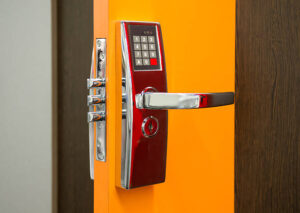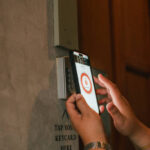Managing Duplicate Keys in High-Security Systems
Managing duplicate keys is no walk in the park, especially when you’re dealing with high security door locks. Picture this: you’ve got a fortress of a building, state-of-the-art locking mechanisms that would make Fort Knox jealous, but then—bam! Someone’s running around with an unauthorized copy of your key. It’s like having a secret backdoor to your house that only strangers know about.
Now let’s chew on this for a bit. Why do duplicates happen? Maybe someone was careless and left their key lying around. Or perhaps there’s been some nefarious activity going on behind the scenes. Either way, it’s crucial to tackle this head-on before it snowballs into something catastrophic.
First off, we need to talk about access control systems. These bad boys are like bouncers at an exclusive club—they decide who gets in and who doesn’t. By integrating electronic key cards or biometric scanners instead of traditional keys, you significantly reduce the risk of unauthorized duplication.
Imagine Sarah from accounting trying to get into her office using just her fingerprint; she can’t exactly leave those lying around now, can she? Plus, if someone tries tampering with these advanced systems—it’s game over for them because they’re immediately flagged by security protocols.
But what if you still have physical keys floating around? It happens more often than you’d think! This is where rekeying comes into play—a process as simple as changing the password on your email account but infinitely more secure given its tangible nature.

Rekeying involves altering the internal configuration so old keys become useless paperweights while new ones reign supreme without replacing entire locksets—saving both time and money!
Let me share an anecdote here: I once knew a guy named Mike who ran his own tech startup outta downtown Chicago (think Silicon Valley vibes). He had all sorts of fancy gadgets protecting sensitive data within their offices—but guess what brought him down one day?
A duplicate key. Yep, you heard that right. One of his employees had a spare made and lost it at a coffee shop. Next thing Mike knew, someone waltzed in after hours and made off with valuable equipment.
So how did Mike bounce back? He went full-on Sherlock Holmes mode—investigating every nook and cranny to find the culprit but also beefing up security measures big time. He installed high-security door locks with patented key control systems where keys couldn’t be duplicated without proper authorization from the manufacturer itself.
But here’s another layer: education is crucial! It’s not just about having top-notch security hardware; your team needs to be on board too. Hold regular training sessions so everyone knows the do’s and don’ts of handling keys responsibly. It’s like teaching kids not to talk to strangers—it might seem basic, but it’s essential for safety.
And let’s not forget about audits—these are your secret weapon against unauthorized access! Conduct periodic checks on who has what key or card, ensuring no funny business slips through unnoticed.
Lastly, always have an emergency plan ready because life loves throwing curveballs when you least expect them! Have backup procedures in place if things go south—a quick rekeying service on speed dial can save heaps of trouble down the line!
Key Duplication Dangers and How to Thwart Them
Imagine coming home after a long day, only to find out someone else has had access to your sanctuary. The culprit? A duplicated key. High security door locks are essential, but they aren’t the whole story.
Key duplication is more common than you might think. Picture this: you’re at a hardware store getting an extra set of keys made for your partner or roommate. Harmless, right? But what if that friendly clerk decides to make an extra copy for themselves? Or worse yet, what if someone with ill intentions gets hold of your key even briefly?
Now let’s dive into some risks associated with duplicated keys:
1. Unauthorized Access: This one’s obvious but crucial—if someone duplicates your key without permission, they can waltz right in.
2. Theft: With easy entry comes the risk of theft or vandalism.
3. Loss of Privacy: Imagine strangers having access to personal spaces and information.
It’s like giving away the combination to your safe! So how do we tackle this problem head-on?
First off, invest in restricted keys. These bad boys can’t be copied willy-nilly because they’re patented and require special equipment that’s not available everywhere.
Next up: high-security cylinders! They’re pick-resistant and bump-proof—a double whammy against would-be intruders.
And don’t forget about electronic locks either; these nifty gadgets use codes instead of physical keys which means no copying!
Another pro tip: keep track of who has copies! Sounds simple enough but you’d be surprised how many people lose count over time (think friends borrowing them “just once”).
If all else fails—or rather before it does—consider rekeying periodically especially after losing a key or ending relationships where trust may have been compromised (no need for drama here).
Let’s not forget the importance of regular maintenance. A lock that’s in tip-top shape is harder to tamper with. Dust off those cobwebs and give your locks a little TLC now and then.
Another angle to consider: smart keys. These are like traditional keys but come with an electronic twist—microchips! They communicate with your lock, ensuring only authorized users can gain entry. It’s like having a bouncer for your front door.
And speaking of technology, how about biometric locks? Fingerprint scanners or even facial recognition systems make it nearly impossible for anyone else to gain access without you knowing. It’s James Bond-level security right at home!
Now let me share a quick story: My buddy Dave once had his house key duplicated by someone he trusted—a neighbor who turned out to be less than trustworthy. One day, Dave came home early from work and found this so-called friend rummaging through his stuff! Needless to say, Dave upgraded all his locks immediately after that incident.
Here’s another nugget of wisdom: never leave spare keys in obvious places like under doormats or flower pots (we’ve all seen those movies). Instead, opt for secure key safes bolted down in discreet locations.
Communication plays its part too; inform everyone who has access about the seriousness of keeping their copies safe and secure—it takes just one slip-up!
Lastly—and I can’t stress this enough—stay vigilant! If something feels off or if you notice any signs of tampering around your locks, don’t hesitate to take action right away.






